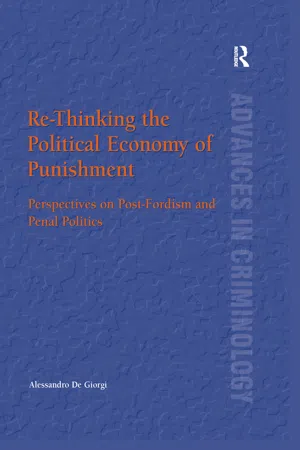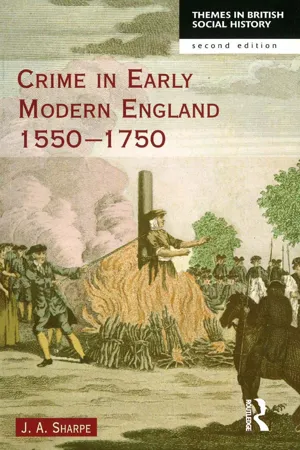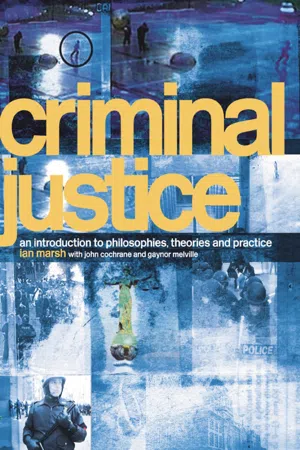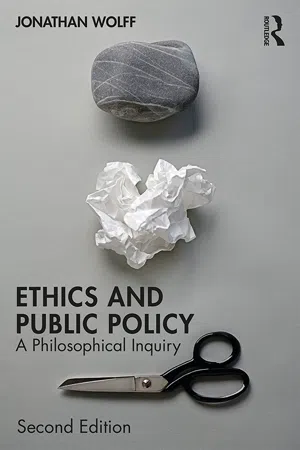History
Crime and Punishment in Industrial Britain
Crime and Punishment in Industrial Britain refers to the legal and social systems of dealing with criminal behavior during the period of industrialization in Britain. This era saw significant changes in crime rates, policing, and the development of prisons. The shift from corporal punishment to incarceration and the rise of industrialization influenced the nature of crime and punishment in this period.
Written by Perlego with AI-assistance
Related key terms
9 Key excerpts on "Crime and Punishment in Industrial Britain"
- eBook - ePub
Re-Thinking the Political Economy of Punishment
Perspectives on Post-Fordism and Penal Politics
- Alessandro De Giorgi(Author)
- 2017(Publication Date)
- Routledge(Publisher)
11The problem was how to overcome the concept of criminology as a science of criminality and as a savoir on the individual and social causes of deviance, and to produce a historical and economic knowledge of the evolution of punitive systems. But this implied that the history of punitive practices could no longer be represented as a linear evolution of legal institutions and practices. The history of punishment had instead to become an economic and social history of penality:Often, legal historians are guided not by an unprejudiced analysis of social laws, but by an evolutionary conception of the development of legal institutions: from barbaric cruelty to the humanitarianism of the relatively perfect legal system which we supposedly enjoy today. They overlook that we are dealing with a very long, now halting, now regressive movement.12The transformations of punishment can be grasped following the evolution of economic relations in history and, in particular, the transition from pre-capitalist economies toward the capitalist mode of production: ‘It is the history of the relations of the two nations … that constitute a people – the rich and the poor.’13Together with Otto Kirchheimer, Georg Rusche would write this history of the two nations and its title would be Punishment and Social Structure . However, the book (published in 1939) was almost ignored both by historians and criminologists for a long time. The political economy of punishment virtually disappeared from the landscape of criminological theory. Only with the second edition of Punishment and Social Structure in 1969, the theoretical program launched by Rusche would be continued by the emerging critical criminology. Both the initial oblivion and the subsequent renewed interest in the political economy of punishment are understandable: Rusche and Kirchheimer’s book appeared in a historical period characterised by a strong adversity to Marxism in the US and to the social sciences in Europe. The emergence of totalitarian regimes, the Second World War, and later the post-war reconstruction with its faith in technocratic approaches to social problems (and criminality): all these factors conjured against Punishment and Social Structure - eBook - ePub
- James A Sharpe(Author)
- 2014(Publication Date)
- Routledge(Publisher)
CHAPTER EIGHTContinuity and Change in Crime and Punishment 1550–1750
In the previous chapters we have ranged freely over a number of areas, and have demonstrated, if nothing else, the variety of approaches that can be employed in studying the history of crime, and the multiplicity of issues involved in the subject. The point has now come for pulling these various threads together, and attempting to understand the general developments and problems relevant to the study of crime in our period. These developments and problems are fairly numerous, and the avenues towards understanding them correspondingly diverse. There is, nevertheless, one essential central theme: that of the possible connections between patterns of crime, patterns of punishment, the attitudes of ruling groups to such matters, and broader socio-economic change. After all, a general consensus suggests that such connections exist: thus a student of crime in Victorian and Edwardian Britain, for example, could claim that‘it has become one of the more widely accepted axioms of our age that an increasing crime rate is the invariable price of material progress’.1 Commentators on earlier periods have, in general, been equally convinced of the presence of such links. Hence the author of a general work on crime in early modern Europe informs us that ‘although crime is usually seen as an index of social distress, it can also be appreciated as an index of social development’, claims that the pattern of European theft, if drawn up, would correlate in time and geography with economic development, and suggests that within the timespan he covers Europe witnessed ‘the emergence of new forms of criminality that reflected the ongoing transition to industrial life’.2 - eBook - ePub
Criminal Justice
An Introduction to Philosophies, Theories and Practice
- Ian Marsh, John Cochrane, Gaynor Melville(Authors)
- 2004(Publication Date)
- Routledge(Publisher)
Chapter 3 ) demonstrates that there have been attempts to reform criminals but they have not detracted from the general motif of punishment as needing to be severe and exemplary. Reform and rehabilitation as ‘aims of punishment’ gained perhaps their widest support in the late 1950s and 1960s, providing a different sense of purpose for punishment and leading to a general optimism about the possibilities of punishment. This was reflected in various new methods of punishment introduced in Britain and elsewhere in this period, including parole, suspended sentences, community service orders and day training centres. The optimism of the 1960s soon gave way to a more sceptical perspective: rising crime rates and high rates of reoffending led to criticisms of the new methods of punishment as being too soft. The emphasis moved away from reform, with senior politicians advocating a hardline approach to punishment that was reflected in ‘short, sharp shock’ sentences being introduced in the early 1980s, and more recently the introduction into Britain of policies based on American ‘boot camps’ and ‘three strikes and out’ policies.However, these newer, harsher initiatives have similarly had little effect on the size of the prison population or on rates of recidivism. Without going into great detail, some overall figures will help illustrate the pressures on the prison system in Britain and provide a context for considering the different philosophies of punishment. The prison population in Britain has continued to rise pretty steadily over the past few decades, with over 71,000 people in Prison Service establishments in 2002 (Home Office data, Social Trends 33, 2003). The number of people given immediate custodial sentences in 1999 was over 105,000 compared to just under 80,000 four years previously (Home Office data, Annual Abstract of Statistics, 2002). (The reason that the number of people sent to prison each year is greater than the prison population is that most prisoners are sentenced to short sentences of less than one year and so not all would be in prison when the annual figure is calculated.) As regards repeat offenders, it would seem that a relatively small number of offenders are responsible for a large proportion of offences. Of the 97,800 males who entered prison in 1999, almost 68 per cent had had previous convictions for ‘standard list offences’ (which include all indictable offences plus some of the more serious summary offences), with 46 per cent having had three or more previous convictions (Home Office data, Annual Abstract of Statistics - eBook - ePub
Criminology
A Sociological Introduction
- Eamonn Carrabine, Alexandra Cox, Pamela Cox, Isabel Crowhurst, Anna Di Ronco, Pete Fussey, Anna Sergi, Nigel South, Darren Thiel, Jackie Turton(Authors)
- 2020(Publication Date)
- Routledge(Publisher)
Transportation was abandoned and the government introduced the Australian ‘ticket of leave’ scheme, the precursor of parole. 1865 The Prison Act formally amalgamated the gaol and house of correction. 1868 Public ceremonies of execution ended. 1877 The Prison Act brought the control of local prisons under central government and a Prison Commission was established under the charge of the Home Secretary. 1895 The Gladstone Committee on Prison reported and recommended rehabilitation and treatment as priorities for the prison system, rather than simply punishing offenders.Why prison?
The question that needs to be answered is why the prison became the dominant response to crime across Europe and North America from the end of the eighteenth century. Until the 1970s the explanation would have been that imprisonment represents an enlightened, humanitarian, progressive response over the barbarism of earlier epochs. This Whig view of history emphasised how early forms of punishment, based on vengeance, irrationality and cruelty had been replaced by informed, professional and expert intervention and would celebrate the zeal of benevolent reformers in explaining why contemporary penal systems exist. However, this interpretation has been widely challenged by a range of ‘revisionist’ histories (Cohen, 1985).The earliest work that looked behind the rhetoric of reformers and asked why particular punishments gain prominence during certain historical periods is provided by George Rusche and Otto Kirchheimer (1939/1968). As Chapter 17 shows, their argument is informed by a Marxist understanding of social relations and highlights the relationships between the form of punishment and the economic requirements of particular modes of production. For instance, they argue that the prison emerged with the advent of industrial capitalism as a means of creating a submissive and regulated workforce.Their account has been criticised for the way in which it provides a one-dimensional explanation of penal relations that prioritises the significance of the labour market at the expense of other factors. A more sophisticated account is Michael Ignatieff’s (1978) analysis of the birth of imprisonment. He rejects economic functionalism and argues that incarceration was a response to the crisis in class relations wrought by the Industrial Revolution as it served to establish the legitimacy of the law and was understood as an element of a larger vision of securing popular consent in an increasingly unequal, class-divided society. - eBook - ePub
- Barry Godfrey, Graeme Dunstall(Authors)
- 2013(Publication Date)
- Willan(Publisher)
4 ). In this text, penal arrangements so described were not simply demonstrative of the brutality, chaos and inhumanity associated with the premodern era on the one hand or the order, rationality and sensitivity associated with the modern on the other. Instead, in charting the history of punishment from the Middle Ages to the early twentieth century, they argue that:Punishment is neither a simple consequence of crime, nor the reverse side of crime, nor a mere means which is determined by the end to be achieved. Punishment must be understood as a social phenomenon freed from both its juristic concept and its social ends. We do not deny that punishment has specific ends, but we do deny that that it can be understood from its ends alone. (Rusche and Kirchheimer, 1939, 1968: 5)Not only did they argue that there was no simplistic relationship between crime and punishment but, in addition, whatever the stated aims of penal development – reform, rehabilitation and so on – there were inevitably much broader social influences and determinants on the form that punishment would take in a given historical period. As Garland (1990: 91) writes of their work, ‘penal policy is taken to be one element within a wider strategy of controlling the poor, in which factories, workhouses, the poor law, and, of course, the labour market, all play corresponding parts’. What they were providing, then, was a materialist analysis of penal change, wherein the main object of their work was to relate the rise of imprisonment to the ascendancy of the capitalist mode of production. Thus Georg Rusche (Rusche, 1933, 1978: 6), the main author of the text, argued in the original research proposal that ‘in the 17th century confinement takes over the role of corporal punishment and death sentences, “humanitarianism” replaces cruelty; wherever there used to be gallows, now prisons stand’. After describing how prisoners then became a useful source of cheap labour in the mercantile period, he adds that: - eBook - ePub
Criminal Justice Theory
An Introduction
- Roger Hopkins Burke(Author)
- 2013(Publication Date)
- Routledge(Publisher)
6 Punishment in Modern SocietyThis chapter discusses the philosophy and theory of punishment in modern societies and locates this debate in the context of the four models of criminal justice development that provide the theoretical underpinnings of this text. It is important to remember that all too often punishment is considered to be a distinct and separate entity from the understanding of penology but it is impossible to legitimately understand one without the other, for imprisonment is, next to capital punishment, the harshest and certainly one of the most commonly used sentences. Without the acknowledgement of penal realities, justifications for punishment become mere intellectual debate. Trying to make sense of familiar concepts such as ‘making the punishment fit the crime’, is not strictly a theoretical question and these are not just philosophical matters of concern to academia. These questions have great practical relevance within the criminal justice process generally and the penal system specifically. By bringing the two together, locating penal trends in theory, and grounding theory in policy, the totality becomes greater than the sum of its parts.According to an old Muslim legend, there was once a rich king who left his servant in charge of his kingdom and in receipt of his riches, while he went on a long journey. Upon returning to his kingdom he found to his dismay that his servant had stolen some of his treasures. The rich king took the servant in front of the judge for sentencing. The judge ordered that both the servant and the king should be punished; the servant because he had broken the law, and the king because, by leaving such a great temptation in the hands of a person with so few possessions and possibly weak character (both realities which the king should have been able to assess), the king was in fact causing the man harm (Ellis and Ellis, 1989). - eBook - ePub
Foucault - The Key Ideas
Foucault on philosophy, power, and the sociology of knowledge: a concise introduction
- Paul Oliver(Author)
- 2010(Publication Date)
- Teach Yourself(Publisher)
There was also a changing sense of morality in society. Offences were seen rather less as crimes against government, authority or those in power, but rather more against the nature of society itself. A criminal offence was a crime against other citizens, against one’s neighbours or community. Crime was a social offence and it was necessary for the punishment to be viewed as appropriate to the offence. There thus developed a social morality where different types of crime were viewed as more unethical than others.InsightTowards the end of the eighteenth century crimes began to be evaluated in terms of the extent of their negative effects on society, and the extent to which they reduced the cohesion of society. For instance, one element of such social cohesion was that people should work hard and gain from the proceeds of that hard work. Theft was seen to be serious because it undermined the advantages of hard work.In the new social context of crime, citizens demanded a form of legal fairness in the evaluation of the likely guilt or innocence of someone. If this was not so, then an innocent person could easily be found guilty of a crime they did not commit. New rules and standards for the assessment of evidence were developed in order to be able to judge someone objectively and fairly. We are familiar in modern times with the way in which certain types of crime are grouped together and attract a comparable type of punishment.So used are we to the logic of this type of judicial and legal system, that we perhaps take it for granted. Yet it was in the nineteenth century that we began to see the emergence of this type of system. The notion that ‘the punishment should fit the crime’ began to emerge as a rational system.Foucault emphasized that ‘detention and imprisonment do not form part of the European penal system before the great reforms of the years 1780–1820’ (Rabinow, Michel Foucault: Ethics , p. 23 - eBook - ePub
Ethics and Public Policy
A Philosophical Inquiry
- Jonathan Wolff(Author)
- 2019(Publication Date)
- Routledge(Publisher)
6CRIME AND PUNISHMENT
§Introduction
Among the concerns of the British public, crime – or perhaps law and order – always features near the top of the list. Yet it is worth pausing to ask the question: ‘what is so bad about crime?’ This, clearly, is rather provocative. If asked in the spirit of an economist one would expect the answer that, when we look into it, crime isn’t such a bad thing after all. Karl Marx ironically remarked on what would now be called the ‘technology-forcing’ aspects of crime. The need for secure locks led to developments in precision engineering which no doubt had many beneficial applications elsewhere. As Marx says, ‘Doesn’t practical chemistry owe just as much to the adulteration of commodities and the efforts to show it up as to the honest zeal for production?’ and ‘Torture alone has given rise to the most ingenious mechanical inventions, and employed many honourable craftsmen in the production of its instruments’ (Marx 1969 [1863], 387). Crime prevention – not to mention the academic study of crime – is a major enterprise and in this way contributes to economic growth and national wealth, albeit the growth of something that detracts from, rather than adds to, human happiness.Crime prevention, in fact, is an excellent illustration of the point that economic activity is not necessarily a good thing in itself. Crime, we know, is something we would rather be without even if it can have some consequences that are useful for some people. Crime is so bad that we punish people, often with imprisonment, if we find them guilty. In this respect crime is almost unique. Apart from severe cases of mental illness or infectious disease, in a liberal society there is no other reason that we take as sufficient to deprive people of their liberty, however irritating they may be. Many philosophers and legal theorists have looked at the question of the moral justification of punishment, and we will follow this up later on in this chapter. Yet to understand the point of punishment, and its possible justifications, we need first, presumably, ask why we find crime so troubling. And that is what we shall explore in the first part of this chapter. - eBook - ePub
Crime And Punishment In England
An Introductory History
- John Briggs, Mr John Briggs, Christopher Harrison, Angus McInnes, David Vincent(Authors)
- 2005(Publication Date)
- Routledge(Publisher)
Part II Crime, police and punishment in England after the Industrial Revolution, 1800–75
Passage contains an image
Chapter 8 The ordering of society
Informal disciplines
A.J.P.Taylor argues that one of the impacts of the demands of the First World War on civilian society was that “The history of the state and of the English people merged for the first time.” The proposal is that until then the state and Britain’s citizens inhabited separate spheres. This means that any exploration of the way in which society was ordered at the beginning of the nineteenth century cannot confine itself to a study of legal codes and the actions of officers of the law. It has to go beyond that and undertake the more subtle task of understanding how the much less easily defined forces of opinion, habit and aspiration affected people’s behaviour in a society that existed long before the emergence of the omni-competent state. W.L.Burn expresses it in these terms:As its far-ranging missionaries of social discipline and progress [individualistic England] took the individual man and woman, impelled by their desire to better their condition in this world and to secure a crown of glory in the next. Behind them were the powerful voluntary agencies, the religious and philanthropic associations, the schools and universities, the hospitals, the innumerable societies for inducing people to do something or refrain from doing something else. In the third line was the State. That was the usual order but it was capable of alteration and on occasions the State moved into first place.Society, then, was in normal times essentially ordered by individual motivation, the desire to stand well with your peers and with your God, and by the informal disciplines of family, factory, congregation and the great estate. This was a society in large measure confined within parochial boundaries. Within such confines, informal disciplines— defined as the disciplines of publicity, respectability, dependency, religion and of work and play—were for the most part tolerably efficient, especially when it is remembered that the shadow of the workhouse, the only formal provision for the poor, was cast across all working-class homes in the kingdom. An absence of formal constraints does not, therefore, mean that society was threateningly anarchic, for although legal constraints may have been few, social disciplines were well entrenched and respected. Landlordism, employer-employee relationships, tied cottages, different forms of patronage, all were part of the woof and warp of everyday life.
Learn about this page
Index pages curate the most relevant extracts from our library of academic textbooks. They’ve been created using an in-house natural language model (NLM), each adding context and meaning to key research topics.








